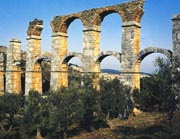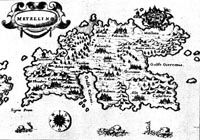Island of Lesbos
Geographic-thematic collecting is an excellent way to dive into the ancient history of
different regions of the ancient Greek world, as well as its economic, military and cultural
aspects. Traditionally, ancient Greek coinage is classified in catalogs by geographical
criteria, as opposed to the later, less diverse and largely
linear presentations by rulers of the Roman Empire and beyond.  Indeed,
for some of these regions one can trace the rich heritage through the characteristics
of coinage and its evolution from the oldest, Archaic times, through the Classical and
Hellenistic periods - even during Roman times, when
"provincial" Imperial coinage displayed
much respect for local Hellenistic Greek traditions. Other times, studying these
regional series might simply evoke added interest in visiting places that exist, some with their
visible historical monuments, to this day. In any event, geographic collecting can be a lot of
fun - and it's hard to run out of areas to collect!
Indeed,
for some of these regions one can trace the rich heritage through the characteristics
of coinage and its evolution from the oldest, Archaic times, through the Classical and
Hellenistic periods - even during Roman times, when
"provincial" Imperial coinage displayed
much respect for local Hellenistic Greek traditions. Other times, studying these
regional series might simply evoke added interest in visiting places that exist, some with their
visible historical monuments, to this day. In any event, geographic collecting can be a lot of
fun - and it's hard to run out of areas to collect!
The island of Lesbos (modern Greek transliteration is usually "Lesvos") may not be an easy
region to collect, as its coinage is relatively scarce today, but it does exemplify the rewards
of focusing on a historically rich locale, in this case within well-defined island boundaries.
One of the largest, yet most underdiscovered (so far, that is) Greek isles,
Lesbos boasts a historical
heritage that surpasses that of many presently more touristy places. In the words of a 19th century English scholar, "Lesbos, the center of Aeolian culture, was the
island of overmastering passions: the personality of the Greek race burned there with a fierce
and steady flame of concentrated feeling." Indeed, the impressive list of lyrical masters
that bloomed on the island,
straddling the line between history and myth, human and divine - like
Sappho, Alkaios, even Arion and Orpheus - amply justifies the lyre,
the badge and symbol of
the island and its capital city, appearing prominently on numerous coinage issues.
In the words of a 19th century English scholar, "Lesbos, the center of Aeolian culture, was the
island of overmastering passions: the personality of the Greek race burned there with a fierce
and steady flame of concentrated feeling." Indeed, the impressive list of lyrical masters
that bloomed on the island,
straddling the line between history and myth, human and divine - like
Sappho, Alkaios, even Arion and Orpheus - amply justifies the lyre,
the badge and symbol of
the island and its capital city, appearing prominently on numerous coinage issues.
